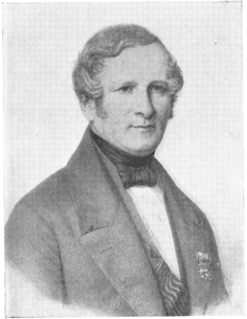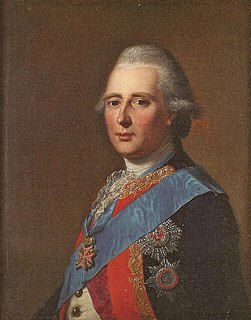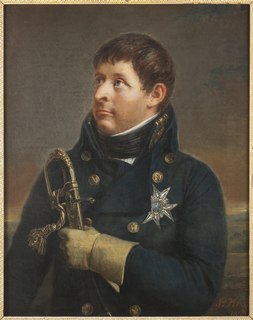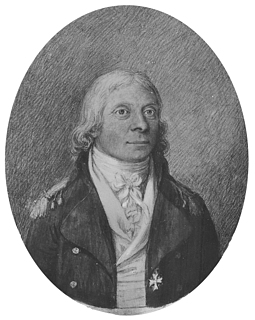
Frederick VI was King of Denmark from 13 March 1808 to 3 December 1839 and King of Norway from 13 March 1808 to 7 February 1814, making him the last king of Denmark–Norway. From 1784 until his accession, he served as regent during his father's mental illness and was referred to as the "Crown Prince Regent". For his motto he chose God and the just cause and since the time of his reign, succeeding Danish monarchs have also chosen mottos in the Danish language rather than the formerly customary Latin. As Frederick VI had no surviving sons to succeed him, he was succeeded on the throne of Denmark by his half-first cousin Christian, who was his father's half-brother's son.

Sweden and Norway or Sweden–Norway, officially the United Kingdoms of Sweden and Norway, and known as the United Kingdoms, was a personal union of the separate kingdoms of Sweden and Norway under a common monarch and common foreign policy that lasted from 1814 until its peaceful dissolution in 1905.

Princess Louise of Denmark and Norway was born to Frederick V of Denmark and Louise of Great Britain. Her eldest daughter, Marie of Hesse-Kassel, was the wife of Frederick VI of Denmark.

Frederik Gottschalck Haxthausen Due was a Norwegian military officer and statesman. Born in Trondheim, he entered the military at an early age, and took part in the Swedish-Norwegian War of 1814. After the two countries entered into union, Due was recruited to the Swedish court, where he was appointed Norwegian state secretary in Stockholm in 1823. In 1841 he became the Norwegian prime minister, and acted as interpreter for Charles XIV John. After resigning in 1858, he spent the years until 1871 as an ambassador to Vienna and Munich.

Frederik Gottschalk von Haxthausen was a Danish-Norwegian army officer, councillor of state, cabinet member and the country's first minister of finance.

Prince Charles of Hesse-Kassel was a cadet member of the house of Hesse-Kassel and a Danish general field marshal. Brought up with relatives at the Danish court, he spent most of his life in Denmark, serving as royal governor of the twin duchies of Schleswig-Holstein from 1769 to 1836 and commander-in-chief of the Norwegian army from 1772 to 1814.

Valentin Christian Wilhelm Sibbern was a Norwegian government minister and representative at the Norwegian Constitutional Assembly.

Charles August or Carl August was a Danish prince. He is best known for serving as Crown Prince of Sweden briefly in 1810, adopted by Charles XIII, before his sudden death from a stroke. Earlier, he had been a general in the Royal Danish Army as well as the Governor-general of Norway. His name before assuming the Swedish title in 1810 was Christian August of Schleswig-Holstein-Sonderburg-Augustenburg, or Christian August of Augustenburg for short.

Prince Frederik of Hesse, Landgrave Friedrich of Hesse-Cassel was a Danish-German nobleman, general and Governor-general of Norway (1810–1813) and the same in the duchies of Schleswig and Holstein (1836–1842).

Johannes Klingenberg Sejersted was a Norwegian military officer.
The Meeting of Notables was a meeting that took place before Norway declared independence from Denmark in 1814.

Frederik Schmidt was a Danish-Norwegian priest, politician, doctor of theology, poet and diarist.
Johan Christopher Ræder was a Norwegian military officer. He was of German and Danish descent, and partly served in the Danish army.
Johan Georg Ræder was a Norwegian military officer.
Prince Christian of Hesse was a German prince and member of the House of Hesse-Kassel. As a son of the Danish Field Marshal Prince Charles of Hesse-Kassel and Princess Louise of Denmark, he was a member of the extended Danish Royal Family and spent his entire life in Denmark.
Bernhard Ditlef von Staffeldt was born on 23 October 1753 in Kenz, Swedish Pomerania as the son of Lieutenant Bernt von Staffeldt, of Pomeranian nobility, and Catherine Eleonore von Platen. Both his parents died in 1755 while he was still a child so he was raised at his married sisters estate in Denmark, and was taken into the court of Queen Sophia Magdalene of Brandenburg-Kulmbach in 1767.

Frederik Wilhelm Stabell was a Norwegian military officer and politician. He was a member of the Norwegian Constituent Assembly in 1814, and ended his military career with the rank of general.
Hans Gram Holst was a Danish-Norwegian army officer.

Lorentz Fisker (1753–1819) was a Danish naval officer who charted the waters of southern Norway and the Kattegat, and organised Norwegian defences against Britain and Sweden.

Henrik Bjelke was a Norwegian military officer who served as Admiral of the Realm of Denmark-Norway from 1662 to 1679. He was in command of the Royal Dano-Norwegian Navy from 1657 to 1679.














